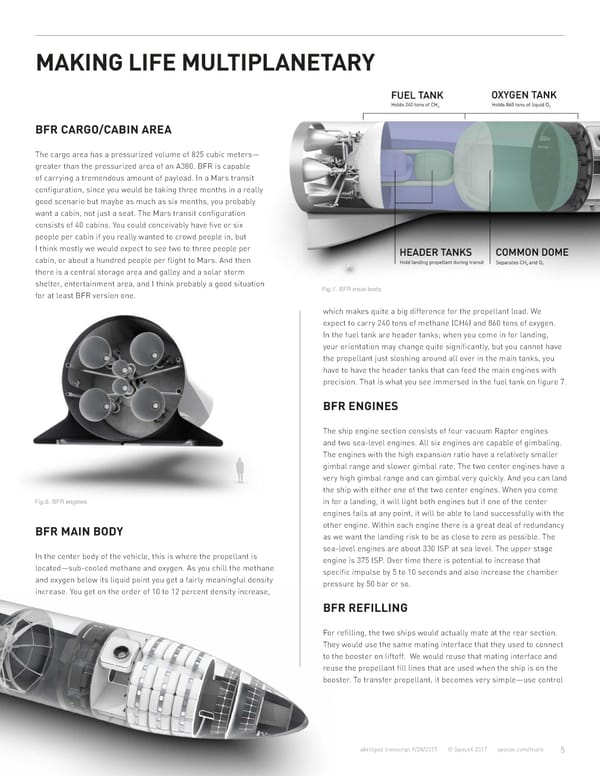MAKING LIFE MULTIPLANETARY BFR CARGO/CABIN AREA The cargo area has a pressurized volume of 825 cubic meters— greater than the pressurized area of an A380. BFR is capable of carrying a tremendous amount of payload. In a Mars transit configuration, since you would be taking three months in a really good scenario but maybe as much as six months, you probably want a cabin, not just a seat. The Mars transit configuration consists of 40 cabins. You could conceivably have five or six people per cabin if you really wanted to crowd people in, but I think mostly we would expect to see two to three people per cabin, or about a hundred people per flight to Mars. And then there is a central storage area and galley and a solar storm shelter, entertainment area, and I think probably a good situation Fig.7. BFR main body for at least BFR version one. which makes quite a big difference for the propellant load. We expect to carry 240 tons of methane (CH4) and 860 tons of oxygen. In the fuel tank are header tanks; when you come in for landing, your orientation may change quite significantly, but you cannot have the propellant just sloshing around all over in the main tanks, you have to have the header tanks that can feed the main engines with precision. That is what you see immersed in the fuel tank on figure 7. BFR ENGINES The ship engine section consists of four vacuum Raptor engines and two sea-level engines. All six engines are capable of gimbaling. The engines with the high expansion ratio have a relatively smaller gimbal range and slower gimbal rate. The two center engines have a very high gimbal range and can gimbal very quickly. And you can land the ship with either one of the two center engines. When you come Fig.6. BFR engines in for a landing, it will light both engines but if one of the center engines fails at any point, it will be able to land successfully with the BFR MAIN BODY other engine. Within each engine there is a great deal of redundancy as we want the landing risk to be as close to zero as possible. The In the center body of the vehicle, this is where the propellant is sea-level engines are about 330 ISP at sea level. The upper stage located—sub-cooled methane and oxygen. As you chill the methane engine is 375 ISP. Over time there is potential to increase that and oxygen below its liquid point you get a fairly meaningful density specific impulse by 5 to 10 seconds and also increase the chamber increase. You get on the order of 10 to 12 percent density increase, pressure by 50 bar or so. BFR REFILLING For refilling, the two ships would actually mate at the rear section. They would use the same mating interface that they used to connect to the booster on liftoff. We would reuse that mating interface and reuse the propellant fill lines that are used when the ship is on the booster. To transfer propellant, it becomes very simple—use control abridged transcript 9/28/2017 © SpaceX 2017 spacex.com/mars 5
 Making Life Multiplanetary Page 4 Page 6
Making Life Multiplanetary Page 4 Page 6